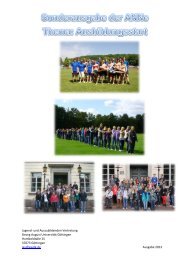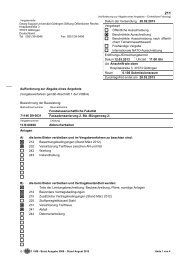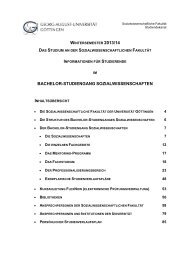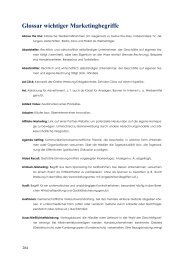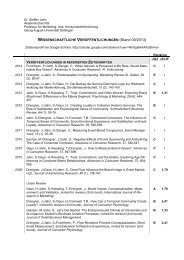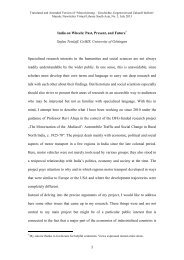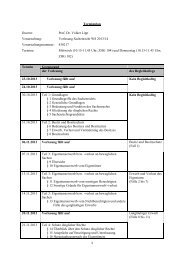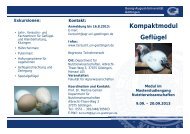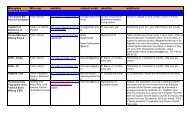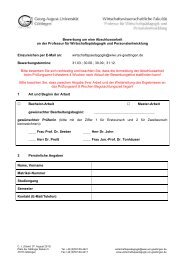CRC 990 - EFForTS - Georg-August-Universität Göttingen
CRC 990 - EFForTS - Georg-August-Universität Göttingen
CRC 990 - EFForTS - Georg-August-Universität Göttingen
You also want an ePaper? Increase the reach of your titles
YUMPU automatically turns print PDFs into web optimized ePapers that Google loves.
<strong>CRC</strong> <strong>990</strong> Ecological and Socioeconomic Functions of Tropical Lowland Rainforest Transformation Systems (Sumatra, Indonesia) Issue 1 / <strong>August</strong> 2013<br />
page 26 von 32<br />
B10<br />
Title: Ecosystem functioning in oil palm plantations<br />
PRESENTER: Claudia Dislich<br />
Land-use change is a main contributor to global change<br />
and affects various ecosystem functions on different<br />
spatial and temporal scales. Here, we aim to assess the<br />
impact of land-use change on ecosystem functions by<br />
taking the example of oil palm plantations. Southeast<br />
Asia has experienced a rapid expansion of oil palm plantations<br />
over the last decades. The role of oil palm expansion<br />
for the global carbon cycle and biodiversity loss<br />
have received increasing attention over the last years.<br />
However, other ecosystem functions such as hydrological<br />
or soil-related functions might also be affected by<br />
conversion of primary or secondary forests into oil palm<br />
plantations. To our knowledge there is not yet a comprehensive<br />
overview of ecosystem functions provided<br />
by oil palm plantations. In this paper we review scientific<br />
knowledge on ecosystem functioning in oil palm<br />
plantations at different spatial and temporal scales.<br />
We compare different types of land-use systems and<br />
natural ecosystems in terms of their consequences for<br />
ecosystem functioning and identify knowledge gaps.<br />
We use the list of ecosystem functions suggested by<br />
de Groot et al. 2002 which are subdivided into regulation,<br />
habitat, production and information functions. We<br />
highlight selected ecosystem functions provided by oil<br />
palm plantations. The impact of oil palm on the global<br />
carbon cycle depends strongly on initial conditions before<br />
planting and on soil type (mineral or peat). On local<br />
to regional scales, the management of oil palm plantations<br />
can affect ground-level ozone concentration with<br />
potentially negative effects for human health and crop<br />
yield. Pollination and biological control are two examples<br />
for functions which have so far only been studied<br />
from the perspective of oil palm as a receiver and not as<br />
a provider of these functions. These functions will thus<br />
need to receive more attention in the future to obtain a<br />
balanced view of ecosystem functions provided by this<br />
ecosystem.<br />
Reference: De Groot, R.S., Wilson, M.A., Boumans,<br />
R.M.J. (2002) A typology for the classification, description<br />
and valuation of ecosystem functions, goods and<br />
services. Ecological Economics 41, 393–408<br />
The 9th International Flora Malesiana Symposium<br />
(http://www.fm9.biologi.lipi.go.id/) takes<br />
place <strong>August</strong> 27-31, 2013 in Bogor. Topic: “Contributions<br />
of Flora Malesiana to the Welfare of People in<br />
Asia”. The symposium is organized by LIPI, Research<br />
Center for Biology (Chairperson Dr. Joeni S. Rahajoe).<br />
The overall <strong>CRC</strong> project will be presented and introduced<br />
by Dr. Damayanti Buchori, Dept. of Pest and Plant<br />
Disease, IPB.<br />
A01<br />
Title: Long-term vegetation dynamics<br />
of mountain rainforests in Central Sulawesi<br />
(Indonesia)<br />
PRESENTER: Siria Biagioni<br />
In order to obtain a deeper understanding of future<br />
environment/ecosystem interactions in tropical ecosystems<br />
a long-term perspective of the interaction between<br />
vegetation dynamics, climate change and human<br />
impact in the past is needed.<br />
Due to the complexity of tropical ecosystems and<br />
site-specific differences on the sedimentary process,<br />
it is very important to have data from multiple sites in<br />
order to better identify the dynamics and vegetation<br />
community responses under different conditions (e.g.<br />
human land use change, climate change).<br />
We present the results of pollen, charcoal and diatoms<br />
analyses of three sediment cores located about 30 km<br />
apart, close to the north-eastern border of the protected<br />
area of the Lore Lindu National Park. The park is situated<br />
in Central Sulawesi and has been a UNESCO “Man<br />
and Biosphere Reserve” since 1977.<br />
The vegetation of the study region consists of species-rich<br />
tropical montane forest. The vegetation gradient<br />
ranges from lowland rainforests below 1000 m<br />
dominated by Fagaceae, to upper montane above 2000<br />
m a.s.l. where conifers are well represented. The climate<br />
of the area is best described by rainfall pattern with<br />
www.uni-goettingen.de/de/310995.html • crc<strong>990</strong>@gwdg.de • Telephone: +49 551 39-1 21 18<br />
JFB Institute for Zoology & Anthropology • Berliner Strasse 28 • D-37073 <strong>Göttingen</strong>




